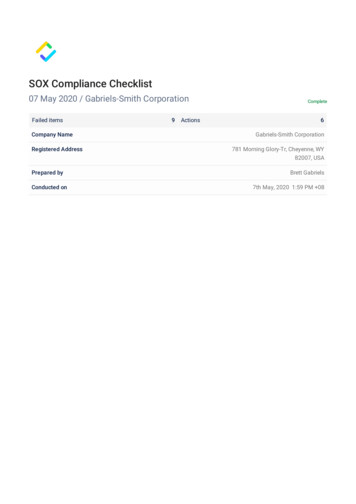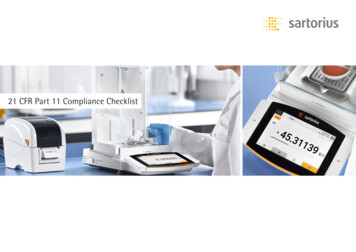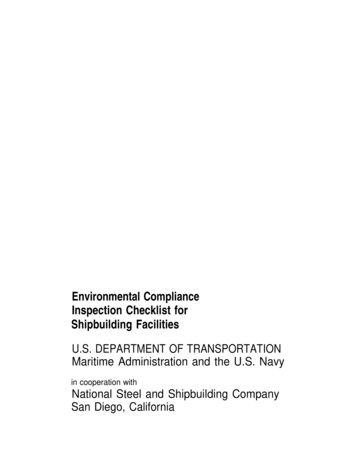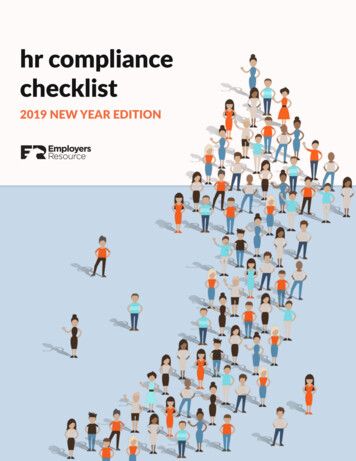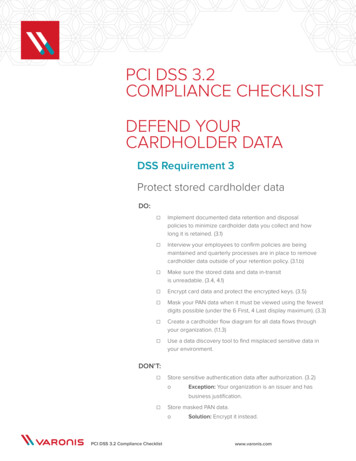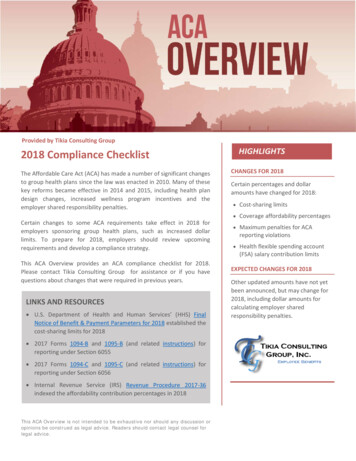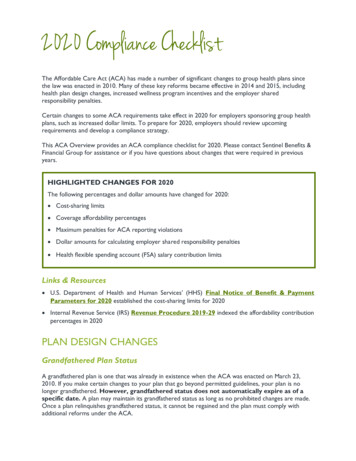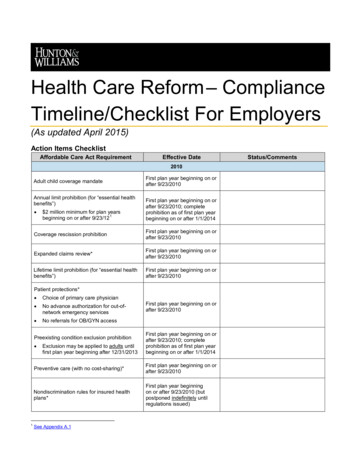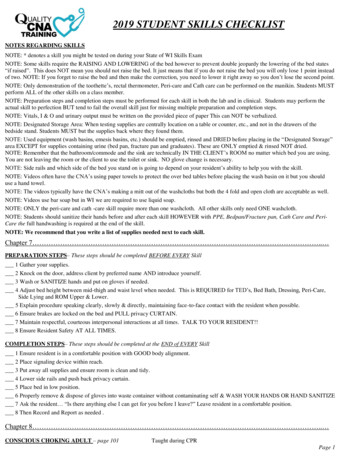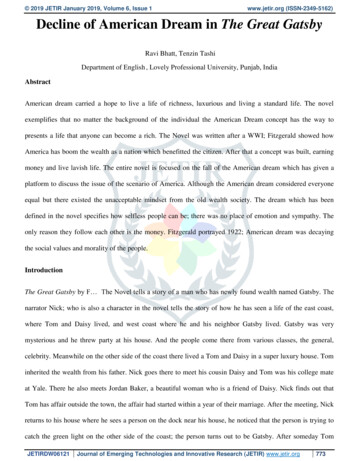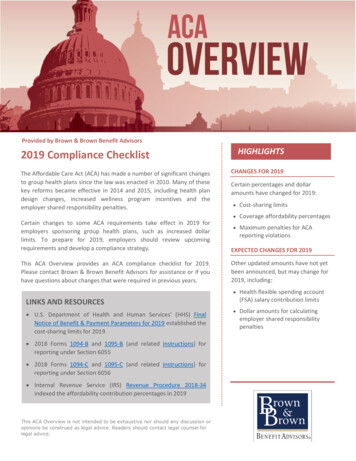
Transcription
Provided by Brown & Brown Benefit Advisors2019 Compliance ChecklistThe Affordable Care Act (ACA) has made a number of significant changesto group health plans since the law was enacted in 2010. Many of thesekey reforms became effective in 2014 and 2015, including health plandesign changes, increased wellness program incentives and theemployer shared responsibility penalties.CHANGES FOR 2019Certain percentages and dollaramounts have changed for 2019: Cost-sharing limits Coverage affordability percentagesCertain changes to some ACA requirements take effect in 2019 foremployers sponsoring group health plans, such as increased dollarlimits. To prepare for 2019, employers should review upcomingrequirements and develop a compliance strategy.EXPECTED CHANGES FOR 2019This ACA Overview provides an ACA compliance checklist for 2019.Please contact Brown & Brown Benefit Advisors for assistance or if youhave questions about changes that were required in previous years.Other updated amounts have not yetbeen announced, but may change for2019, including: Maximum penalties for ACAreporting violations Health flexible spending accountLINKS AND RESOURCES U.S. Department of Health and Human Services’ (HHS) FinalNotice of Benefit & Payment Parameters for 2019 established thecost-sharing limits for 2019 2018 Forms 1094-B and 1095-B (and related instructions) forreporting under Section 6055 2018 Forms 1094-C and 1095-C (and related instructions) forreporting under Section 6056 Internal Revenue Service (IRS) Revenue Procedure 2018-34indexed the affordability contribution percentages in 2019This ACA Overview is not intended to be exhaustive nor should any discussion oropinions be construed as legal advice. Readers should contact legal counsel forlegal advice.(FSA) salary contribution limits Dollar amounts for calculatingemployer shared responsibilitypenalties
PLAN DESIGN CHANGESGrandfathered Plan StatusA grandfathered plan is one that was already in existence when the ACA was enacted on March 23,2010. If you make certain changes to your plan that go beyond permitted guidelines, your plan is nolonger grandfathered. However, grandfathered status does not automatically expire as of a specificdate. A plan may maintain its grandfathered status as long as no prohibited changes are made. Once aplan relinquishes grandfathered status, it cannot be regained and the plan must comply with additionalreforms under the ACA.Contact Brown & Brown Benefit Advisors if you have questions about changes you have made, or areconsidering making, to your plan.Review your plan’s grandfathered status: If you have a grandfathered plan, determine whether it will maintain its grandfathered status forthe 2019 plan year. Grandfathered plans are exempt from some of the ACA’s mandates. Agrandfathered plan’s status will affect its compliance obligations from year to year. If your plan will lose its grandfathered status for 2019, confirm that the plan has all of theadditional patient rights and benefits required by the ACA for non-grandfathered plans. Thisincludes, for example, coverage of preventive care without cost-sharing requirements. If your plan will keep its grandfathered status, continue to provide the Notice of GrandfatheredStatus in any plan materials provided to participants and beneficiaries that describe the benefitsprovided under the plan (such as the plan’s summary plan description and open enrollmentmaterials). Model language is available.Cost-sharing LimitsEffective for plan years beginning on or after Jan. 1, 2014, non-grandfathered health plans are subject tolimits on cost sharing for essential health benefits (EHB). The ACA’s overall annual limit on cost sharing(also known as an out-of-pocket maximum) applies for all non-grandfathered group health plans,whether insured or self-insured. Under the ACA, a health plan’s out-of-pocket maximum for EHB maynot exceed 7,900 for self-only coverage and 15,800 for family coverage, effective for plan yearsbeginning on or after Jan. 1, 2019.Health plans with more than one service provider may divide the out-of-pocket maximum acrossmultiple categories of benefits, rather than reconciling claims across multiple service providers. Thus,health plans and issuers may structure a benefit design using separate out-of-pocket maximums for EHB,provided that the combined amount does not exceed the annual out-of-pocket maximum limit for thatyear. For example, in 2019, a health plan’s self-only coverage may have an out-of-pocket maximum of2This ACA Overview is not intended to be exhaustive nor should any discussion or opinions be construed as legaladvice. Readers should contact legal counsel for legal advice. 2018 Zywave, Inc. All rights reserved.
6,000 for major medical coverage and 1,900 for pharmaceutical coverage, for a combined out-ofpocket maximum of 7,900.Beginning with the 2016 plan year, the self-only annual limit on cost sharing applies to each individual,regardless of whether the individual is enrolled in self-only coverage or family coverage. This embedsan individual out-of-pocket maximum in family coverage so that an individual’s cost sharing for essentialhealth benefits cannot exceed the ACA’s out-of-pocket maximum for self-only coverage.Note that the ACA’s cost-sharing limit is higher than the out-of-pocket maximum for high deductiblehealth plans (HDHPs). In order for a health plan to qualify as an HDHP, the plan must comply with thelower out-of-pocket maximum limit for HDHPs. HHS provided FAQ guidance on how this ACA rule affectsHDHPs with family deductibles that are higher than the ACA’s cost-sharing limit for self-only coverage.According to HHS, an HDHP that has a 10,000 family deductible must apply the annual limitation oncost sharing for self-only coverage ( 7,350 in 2018) to each individual in the plan, even if this amount isbelow the 10,000 family deductible limit. Because the 7,350 self-only maximum limitation on costsharing exceeds the 2018 minimum annual deductible amount for HDHPs ( 2,700), it will not cause aplan to fail to satisfy the requirements for a family HDHP.Check your plan’s cost-sharing limits: Review your plan’s out-of-pocket maximum to make sure it complies with the ACA’s limits forthe 2019 plan year ( 7,900 for self-only coverage and 15,800 for family coverage). If you have an HSA-compatible HDHP, keep in mind that your plan’s out-of-pocket maximummust be lower than the ACA’s limit. For 2019, the out-of-pocket maximum limit for HDHPs is 6,750 for self-only coverage and 13,500 for family coverage. If your plan uses multiple service providers to administer benefits, confirm that the plan willcoordinate all claims for EHBs across the plan’s service providers, or will divide the out-of-pocketmaximum across the categories of benefits, with a combined limit that does not exceed themaximum for 2019. Confirm that the plan applies the self-only maximum to each individual in the plan, regardless ofwhether the individual is enrolled in self-only coverage or family coverage.Health FSA ContributionsEffective for plan years beginning on or after Jan. 1, 2013, an employee’s annual pre-tax salary reductioncontributions to a health FSA must be limited to 2,500 (as adjusted for inflation). The 2,500 limit wasincreased to 2,550 for taxable years beginning in 2015 and 2016, then increased to 2,600 for taxableyears beginning in 2017, and then increased again to 2,650 for taxable years beginning in 2018. The IRShas not yet released the FSA dollar limit for taxable years beginning in 2019. The IRS typically announceswhether the limit will be adjusted for the next year toward the end of the year.3This ACA Overview is not intended to be exhaustive nor should any discussion or opinions be construed as legaladvice. Readers should contact legal counsel for legal advice. 2018 Zywave, Inc. All rights reserved.
The limit does not apply to non-elective employer contributions to the health FSA (such as matchingcontributions or flex credits), though employer contributions that employees may elect to receive incash or as a taxable benefit will count toward the limit. Other ACA requirements may impact or limit thetotal amount that may be contributed to a health FSA, but non-elective employer contributionsgenerally do not reduce the health FSA limit for the employee. Additionally, the health FSA limit doesnot impact contributions under other employer-provided coverage. For example, employee salaryreduction contributions to an FSA for dependent care or adoption care assistance are not affected bythe health FSA limit.Update your health FSA’s contribution limit: Work with your advisors to monitor IRS guidance on the health FSA limit for 2019. Once the 2019 health FSA limit is announced, confirm that your health FSA will not allowemployees to make pre-tax contributions in excess of the limit for the 2019 plan year. If the 2019 limit is announced too late for your open enrollment, you can use the 2018 limit toensure compliance. Communicate the health FSA limit to employees as part of the open enrollment process.SUMMARY OF BENEFITS AND COVERAGE (SBC)Health plans and health insurance issuers must provide an SBC to applicants and enrollees to help themunderstand their coverage and make coverage decisions. Plans and issuers must provide the SBC toparticipants and beneficiaries who enroll or re-enroll during an open enrollment period, as well as toparticipants and beneficiaries who enroll other than through an open enrollment period (includingindividuals who are newly eligible for coverage and special enrollees).The SBC must follow strict formatting requirements. The Departments provided templates and relatedmaterials, including instructions and a uniform glossary of coverage terms, for use by plans and issuers.On April 6, 2016, the Departments issued a new template and related materials for the SBC, effective foruse with respect to open enrollment periods or plan or policy years beginning on or after April 1, 2017.Begin using the new SBC template: Ensure that you are using the appropriate SBC template for the 2019 plan year. For self-funded plans, the plan administrator is responsible for creating and providing the SBC.For insured plans, the issuer is required to provide the SBC to the plan sponsor. Both the planand the issuer are obligated to provide the SBC, although this obligation is satisfied for bothparties if either one provides the SBC. If you have an insured plan, confirm whether your healthinsurance issuer will assume responsibility for providing the SBCs.4This ACA Overview is not intended to be exhaustive nor should any discussion or opinions be construed as legaladvice. Readers should contact legal counsel for legal advice. 2018 Zywave, Inc. All rights reserved.
HIPAA CERTIFICATIONThe ACA includes a requirement for health plans to file a statement with HHS certifying their compliancewith the Health Insurance Portability and Accountability Act’s (HIPAA) electronic transaction standardsand operating rules. These HIPAA requirements are often referred to as the electronic data interchange(EDI) rules.However, on Oct. 4, 2017, HHS withdrew its proposed rule in order to re-examine the issues and exploreoptions and alternatives to comply with the HIPAA certification requirement. As a result, group healthplan sponsors will not be required to certify their HIPAA compliance until HHS issues new guidance.Although health plans are not required to certify their HIPAA compliance at this time, there is anenforcement process in place for the EDI rules. Civil monetary penalties and criminal penalties may beimposed on a covered entity that fails to comply with the EDI rules. Thus, health plans and businessassociates that conduct standard transactions should confirm that they are complying with the EDI rules.Analyze your obligations for the HIPAA certification: Confirm whether your health plan is complying with any applicable EDI rules. Work with your advisors to monitor whether HHS issues any additional guidance on the HIPAAcertification requirement.EMPLOYER SHARED RESPONSIBILITY RULESUnder the ACA’s employer shared responsibility rules, applicable large employers (ALEs) are required tooffer affordable, minimum value (MV) health coverage to their full-time employees (and dependentchildren) or pay a penalty. These employer shared responsibility requirements are also known as the“employer mandate” or “pay or play” rules.An ALE will be subject to penalties if one or more full-time employees receive a subsidy for purchasinghealth coverage through an Exchange. An individual may be eligible for an Exchange subsidy eitherbecause the ALE: Does not offer coverage to that individual; or Offers coverage that is “unaffordable” or does not provide “minimum value.”This checklist will help you evaluate your possible liability for an employer shared responsibility penaltyfor 2019. Please keep in mind that this summary is a high-level overview of the employer sharedresponsibility rules. It does not provide an in-depth analysis of how the rules will affect your organization.Please contact Brown & Brown Benefit Advisors for more information on these rules and how they mayapply to you.5This ACA Overview is not intended to be exhaustive nor should any discussion or opinions be construed as legaladvice. Readers should contact legal counsel for legal advice. 2018 Zywave, Inc. All rights reserved.
Applicable Large Employer StatusThe ACA’s employer shared responsibility rules apply only to ALEs. ALEs are employers with 50 or morefull-time employees (including full-time equivalent employees, or FTEs) on business days during thepreceding calendar year. Employers determine each year, based on their current number of employees,whether they will be considered an ALE for the following year.Determine your ALE status for 2019: Calculate the number of full-time employees for each calendar month in 2018. A full-timeemployee is an employee who is employed, on average, at least 30 hours of service per week or130 hours for the calendar month. Calculate the number of FTEs for each calendar month in 2018 by calculating the aggregatenumber of hours of service (but not more than 120 hours for any employee) for all employeeswho were not full-time employees for that month and dividing the total hours of service by 120. Add the number of full-time employees and FTEs (including fractions) calculated above for eachmonth in 2018. Add up these monthly numbers and divide the sum by 12. Disregard fractions. If your result is 50 or more, you are likely an ALE for 2019. Keep in mind that there is a special exception for employers with seasonal workers. If yourworkforce exceeds 50 full-time employees (including FTEs) for 120 days or fewer during the 2018calendar year, and the employees in excess of 50 who were employed during that time wereseasonal workers, you will not be an ALE for 2019. Companies under common ownership may have to be combined to determine their ALE status.Offering Coverage to Full-time EmployeesTo correctly offer coverage to full-time employees, ALEs must determine which employees are full-timeemployees under the employer shared responsibility rule definition. A full-time employee is anemployee who was employed, on average, at least 30 hours of service per week (or 130 hours ofservice in a calendar month).The IRS provided two methods for determining full-time employee status for purposes of offeringcoverage—the monthly measurement method and the look-back measurement method.MONTHLYMEASUREMENTMETHODInvolves a month-to-month analysis where full-time employees are identifiedbased on their hours of service for each month. This method is not based onaveraging hours of service over a prior measurement method. Month-to-monthmeasuring may cause practical difficulties for employers that have employeeswith varying hours or employment schedules, and could result in employeesmoving in and out of employer coverage on a monthly basis.6This ACA Overview is not intended to be exhaustive nor should any discussion or opinions be construed as legaladvice. Readers should contact legal counsel for legal advice. 2018 Zywave, Inc. All rights reserved.
An optional safe harbor method for determining full-time status that can providegreater predictability for determining full-time status. The details of this methodare based on whether the employees are ongoing or new, and whether newemployees are expected to work full time or are variable, seasonal or part time.LOOK-BACKMEASUREMENTMETHODThis method involves a measurement period for counting hours of service, anadministrative period that allows time for enrollment and disenrollment, and astability period when coverage may need to be provided, depending on anemployee’s average hours of service during the measurement period.If an employer meets the requirements of the safe harbor, it will not be liablefor penalties for employees who work full time during the stability period, ifthey did not work full-time hours during the measurement period.Determine your full-time employees: Use the monthly measurement method or the look-back measurement method to confirm thathealth coverage will be offered to all full-time employees (and dependent children). If you haveemployees with varying hours, the look-back measurement method may be the best fit for you. To use the look-back measurement method, you will need to select your measurement,administrative and stability periods. Please contact Brown & Brown Benefit Advisors for moreinformation.Applicable PenaltiesAn ALE is only liable for a penalty under the employer shared responsibility rules if at least one full-timeemployee receives a subsidy for coverage purchased through an Exchange. Employees who are offeredhealth coverage that is affordable and provides MV are generally not eligible for these Exchangesubsidies. Depending on the circumstances, one of two penalties may apply under the employer sharedresponsibility rules—the 4980H(a) penalty or the 4980H(b) penalty.The 4980H(a) Penalty—Penalty for ALEs not Offering CoverageUnder Section 4980H(a), an ALE will be subject to a penalty if it does not offer coverage to “substantiallyall” full-time employees (and dependents) and any one of its full-time employees receives a premiumtax credit or cost-sharing reduction toward his or her Exchange plan. The 4980H(a) penalty will not applyto an ALE that intends to offer coverage to all of its full-time employees, but that fails to offer coverageto a few of these employees, regardless of whether the failure to offer coverage was inadvertent.An ALE will satisfy the requirement to offer minimum essential coverage to “substantially all” of its fulltime employees and their dependents if it offers coverage to at least 95 percent—or fails to offercoverage to no more than 5 percent (or, if greater, five)—of its full-time employees (and dependents).According to the IRS, the alternative margin of five full-time employees is designed to accommodate7This ACA Overview is not intended to be exhaustive nor should any discussion or opinions be construed as legaladvice. Readers should contact legal counsel for legal advice. 2018 Zywave, Inc. All rights reserved.
relatively small ALEs, because a failure to offer coverage to a handful of full-time employees mightexceed 5 percent of the ALE’s full-time employees.Under the ACA, the monthly penalty assessed on ALEs that do not offer coverage to substantially all fulltime employees and their dependents is equal to the ALE’s number of full-time employees (minus 30) X1/12 of 2,000 (as adjusted), for any applicable month. After 2014, the 2,000 amount is indexed forthe calendar year, as follows: 2,080 for 2015 2,160 for 2016 2,260 for 2017 2,320 for 2018The 4980H(b) Penalty—Penalty for ALEs Offering CoverageALEs that do offer coverage to substantially all full-time employees (and dependents) may still besubject to
2019 Compliance Checklist The Affordable Care Act (ACA) has made a number of significant changes to group health plans since the law was enacted in 2010. Many of these key reforms became effective in 2014 and 2015, including health plan design changes, increased wellness program inc
